Frontera Cocina at Disney Springs
commARCH: Sweetwater by NELSON Worldwide
Since 1979, Sweetwater has provided musicians with the best selection, service, and support needed to create music. Read more on commARCH.
Mixed-Use Developers Expand Into Pop-up Villages
For years, brands and retailers have leaned into pop-ups as a way to uniquely connect with niche consumers and ultimately, create buzz. Now, mixed-use developers are taking it to the next level with the “pop-up village” concept. These environments feature several spaces, instead of a singular experience, and create a mini mixed-use destination, if you will.
This month NELSON teammates explored two of these villages—The Current located at the Boston Seaport and The Box Shops in the West Loop of Chicago—clearly designed to connect with up-and-coming urban markets.
The Current
Located in the Seaport District of downtown Boston, The Current, by WS Development is a retail village that is home to “an ever-evolving lineup of brands and businesses that spin the concept of a traditional storefront into something truly special.” As guest tenant(s) rotate, each village expression is strategically woven together with a theme. This POV-driven location gives consumers the chance to discover something new throughout the course of the year, while also acting as an innovative retail incubator for brands. Previously, The Current curated a collection of female business founders and distinctly branded the experience as She-Village.
At the moment, The Current is hosting the infamous best-in-beauty brand, Glossier. While we’ve watched Glossier make waves in the retail world, this location is differentiated from its NYC flagship and other pop-ups. Making its debut in Boston, the brand did a full takeover of the Current’s nine freestanding spaces. Each individual space creates a focused display for each of Glossier’s product categories (makeup, skincare, body care and fragrance) or brings to life immersive, “selfie-worthy” installations that celebrate key brand elements. Shoppers order product as they shop each category’s space, and then head to a dedicated pick-up location that serves the entire destination. The execution is undeniably Glossier as each exterior and employee is decked out in the brand’s iconic Millennial pink.
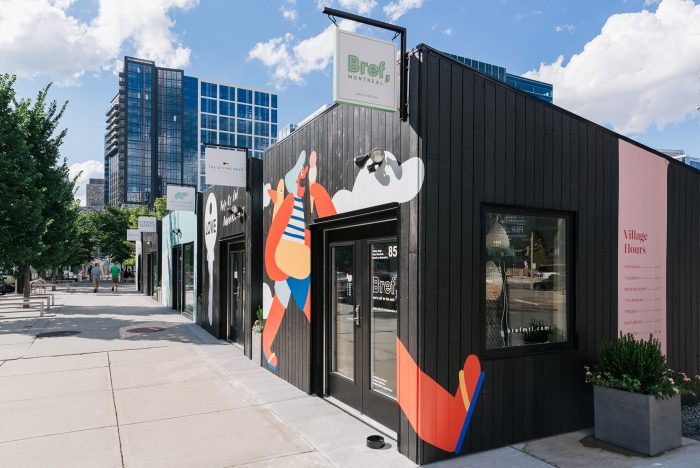
The Box Shops by Related
At The Box Shops in West Loop Chicago, shoppers can enjoy a “rotating roster of local retailers” in a temporary retail market made of repurposed shipping containers. Powered by Related, the developer behind Hudson Yards, and in partnership with Equinox and Boombox, The Box Shops consist of seven spaces, none over 320 square feet in size with vendor leases starting at $1,000/month. This strategic retail solution provides local start-ups with access to an area they otherwise may not have been able to afford, while also bringing retail into parts of the city where it’s currently lacking. Related reports that the activation has brought more awareness to the site, where they’re building a hotel and apartments nearby, as well as its bigger developments.
The night we stumbled upon the space, you could shop for gifts or jewelry, grab a beer or Israeli street food, and hear a DJ’s music trickle into the streets. It featured an outdoor lounge that invited you to stay awhile and “sip, shop or play”—a non-committal way to enjoy a bustling Chicago neighborhood that often requires a reservation.
We’ll readily admit that we’re a sucker for any kind of new experience, knowing we can always learn something from it—but we predict this pop-up village concept might be here to stay. It steals the novelty of a traditional pop-up, while also providing a reliable, go-to retail destination. And, we’re excited to see mixed-use developers taking the lead to create valuable experiences for tenants and consumers, alike.
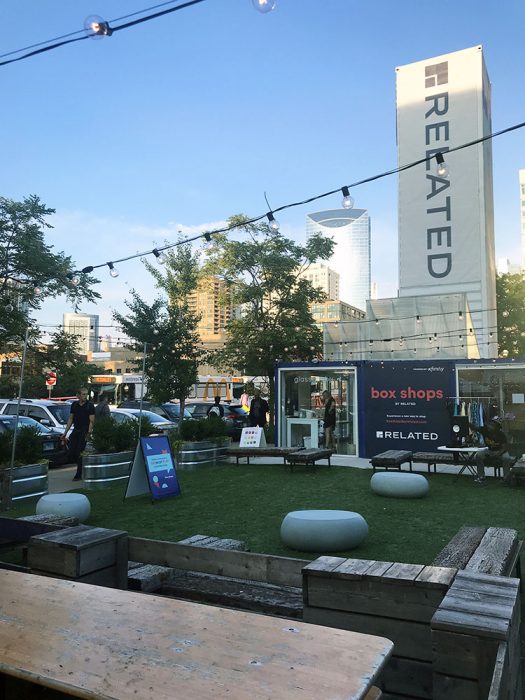
Technology Workplace Project
Emory Brain Health Center
Brand Homes: Immersive Experiences With Staying Power
As more first-time retailers and digitally native brands transition into physical environments (as COVERGIRL did with its opening in Times Square), and existing retail brands compete with larger flagship destinations and more experiential pop-ups, a new breed of consumer immersion is emerging … the “Brand Home.” Brand homes are the quintessential opportunity for the most immersive manifestation of your brand purpose, personality and assets. Brand homes are in a class all their own—an underutilized asset with priceless potential to drive brand equity and buzz, strengthen loyalty and create one-on-one experiences with consumers.
These destinations have the potential to draw guests from miles away and keep their attention for hours at a time—enabling brands to deep-dive into storytelling, unabashedly celebrate people, products, and services, and, ultimately, create lasting emotional connections and memories that turn interest into loyalty, and loyalty into passion. We define brand homes as irreplicable experiences that are long-term investments owned entirely by your brand, and often located near company headquarters.
Though not always mutually exclusive, we see brands experimenting with four types of brand homes:
1. Branded Marketplace
Resembling flagships of many leading retailers, this type is often utilized most by CPG businesses to create an ownable, experiential, retail-centric destination that brings product portfolios to the forefront while overcoming barriers of traditional retail channels. Some brands, like J.M. Smucker, celebrate product assortments from several brands under one parent company story.
Others amplify environmental design and programming to push the marketplace concept into more of a true experience. The Tillamook Creamery in Oregon has an expansive store to merchandise its countless dairy-based products, a food hall that features a local chef’s interpretation of Tillamook classics, in addition to an educational exhibit about farming.
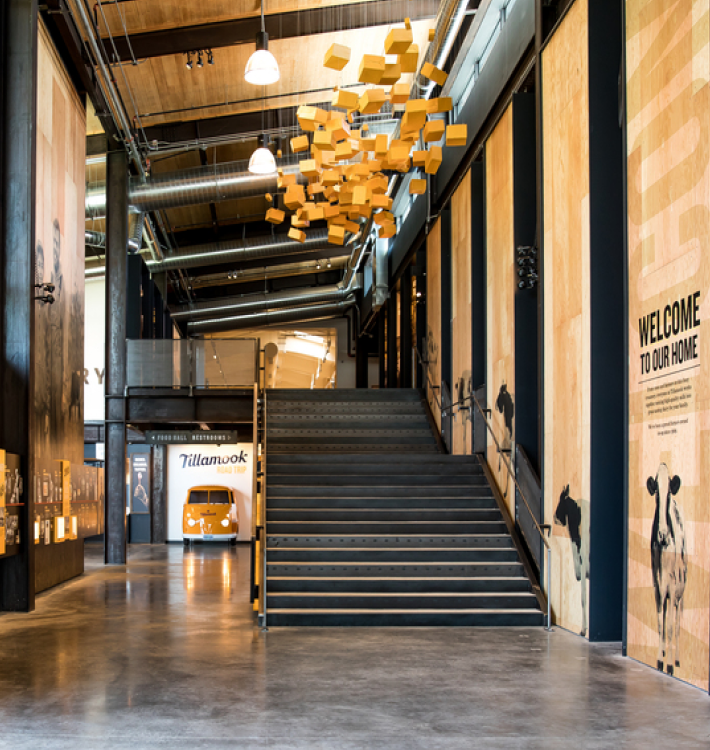
Tillamook Creamery
2. Brand Immersions
Inviting exclusive, behind-the-scenes access where consumers have the opportunity not just to interact with the brand, but to become part of it. A simple, yet highly on-brand example is the Ben & Jerry’s Factory Tour where guests can go on a 30-minute tour to get a view into the manufacturing process, learn about the company’s values, browse the quirky gift shop, and of course, enjoy a sample. The experience is littered with photo ops, and the iconic Flavor Graveyard is easily the most memorable moment. For a fee, guests can also opt into a private, hands-on Flavor Fanatic Experience to help craft what’s next in ice cream.
The Bourbon Trail in Kentucky is perhaps the highest concentration of brand homes in the world—though not all are created equal. One to mention is Maker’s Mark Distillery, where you can tour the distillery and cellar, dine at their featured restaurant and even dip a bottle of bourbon into the signature red wax yourself.
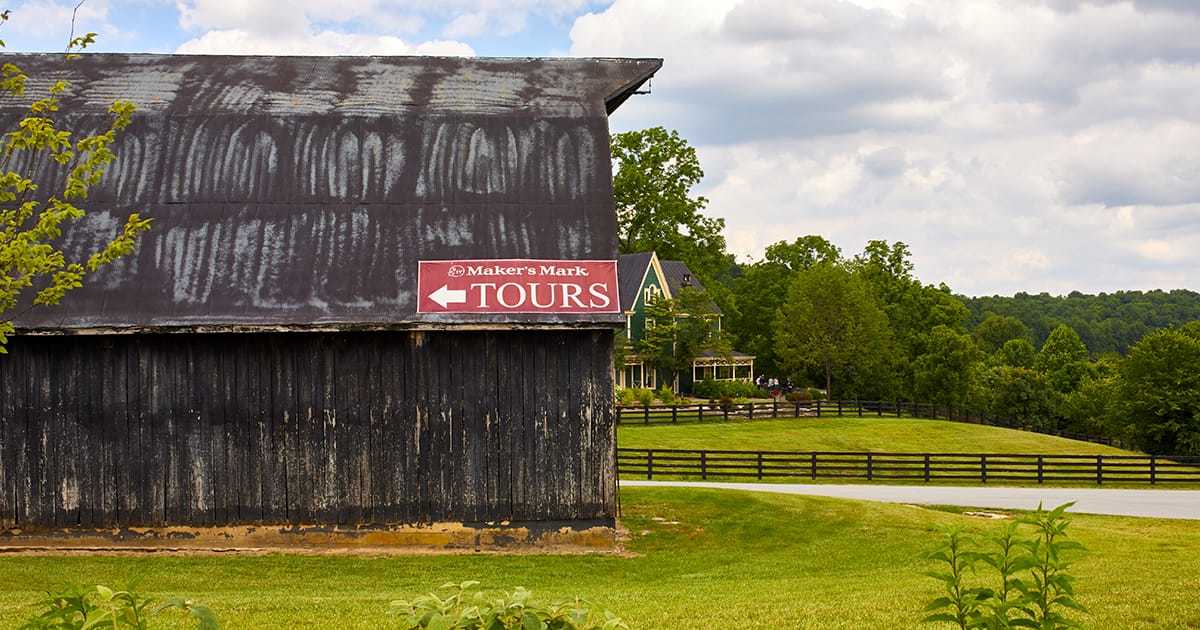
Maker’s Mark Distillery Tour
3. Brand Museums
Dialing up history, heritage and storied exhibits, this type celebrates the brand’s past, alludes to its legacy and highlights its impact on culture. When the Cincinnati Reds wanted to celebrate the team’s 150th anniversary, they partnered with FRCH NELSON to reimagine the Reds Hall of Fame. Recently re-opened in downtown Cincinnati, the team created a dynamic series of galleries paying tribute to players, historic memorabilia and our record-setting teams. Interactive exhibits engage guests, including opportunities to create custom baseball cards and simulate broadcasts. Gucci Garden also recently debuted its renovation to the previous Gucci Museo in Florence, Italy. Designed by the brand’s creative director, the stunning Galleria showcases classic and obscure artifacts across the brand’s tenure, while the adjoining boutique and restaurant both resemble those you might find in a world-class art museum.
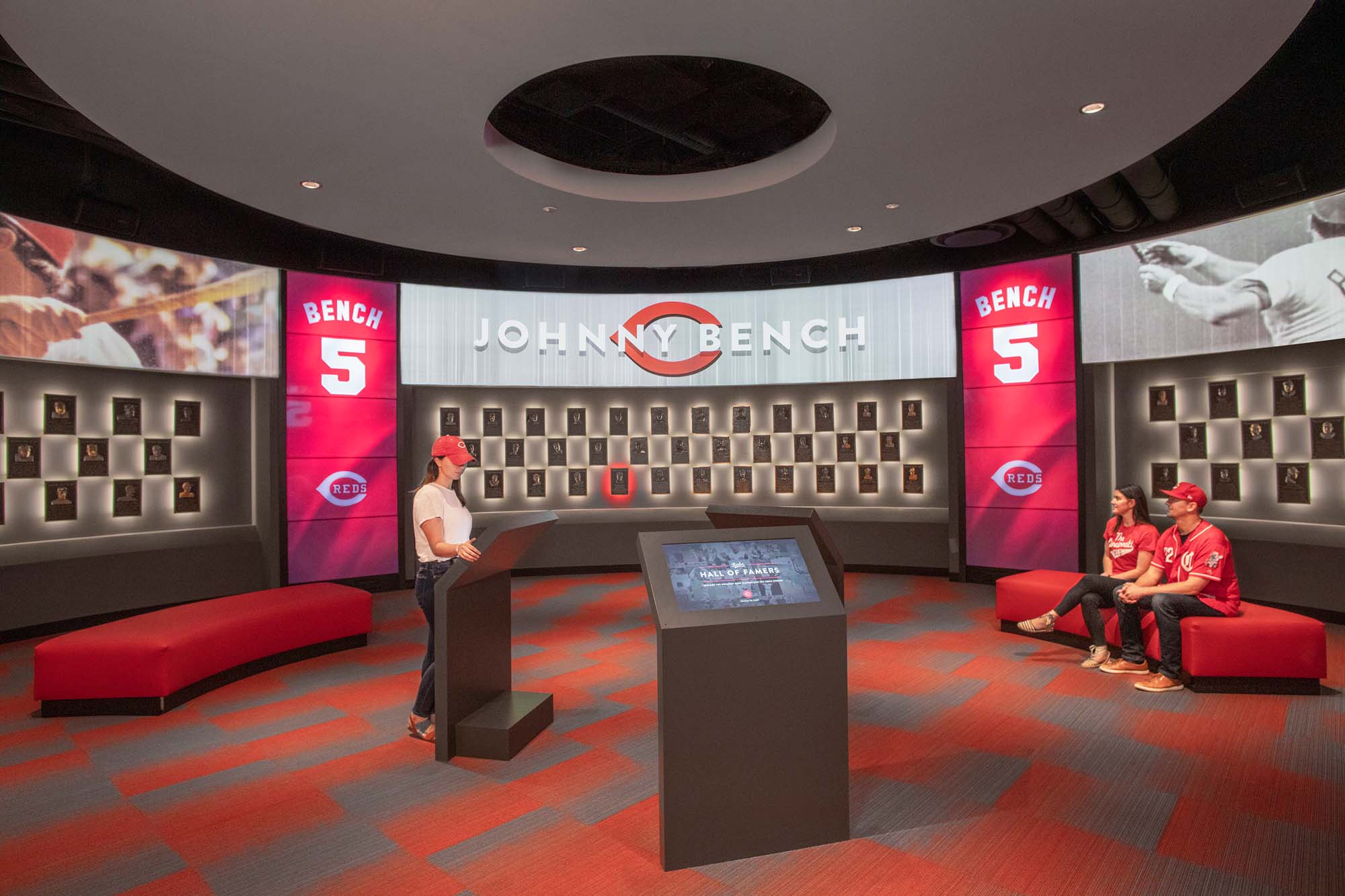
Cincinnati Reds Hall of Fame
4. Branded Platforms
The most intensive of brand homes, this type illustrates how the brand fits into consumer lifestyles through meaningful adjacencies and strategically leverages the brand home touchpoint as a way to extend its brand positioning. The Guinness Storehouse has become a central destination in Dublin, Ireland with its Taste Experience, World of Advertising exhibit and six bars and restaurants that often host rugby game pre-parties, food festivals and even an Airbnb stay. The Henry Ford Museum in Michigan has redefined what it means to be a brand home by making its experience a celebration of innovation of all kinds, not just those directly connected to the brand. Guests can certainly see a bounty of old Ford cars, but they can also enjoy the Museum of American Innovation with exhibits from civil rights history to agriculture, as well as visit Edison’s Lab and Henry Ford’s Birthplace. The Ford Rouge Factory Tour also culminates in a highly sensorial experience that showcases the engineering behind a Ford F-150 truck.
Hershey has expertly leaned into statement retail and a completely unique expression of brand homes between Hershey’s Chocolate World flagship in Times Square and Hersheypark in none other than Hershey, Pennsylvania—establishing the brand as a leader in demonstrating the importance of a vast portfolio of unique brand experiences. And Eataly has exceeded its own best-in-class stores with the opening of FICO Eataly World, the world’s largest “agri-food park” located in Bologna, Italy, just over three hours away from the company’s headquarters. From markets to restaurants, farms to workshops, sustainable installations to themed activities, this 20-acre destination is a benchmark in bringing a deep-rooted brand manifesto to life in a truly tangible experience.
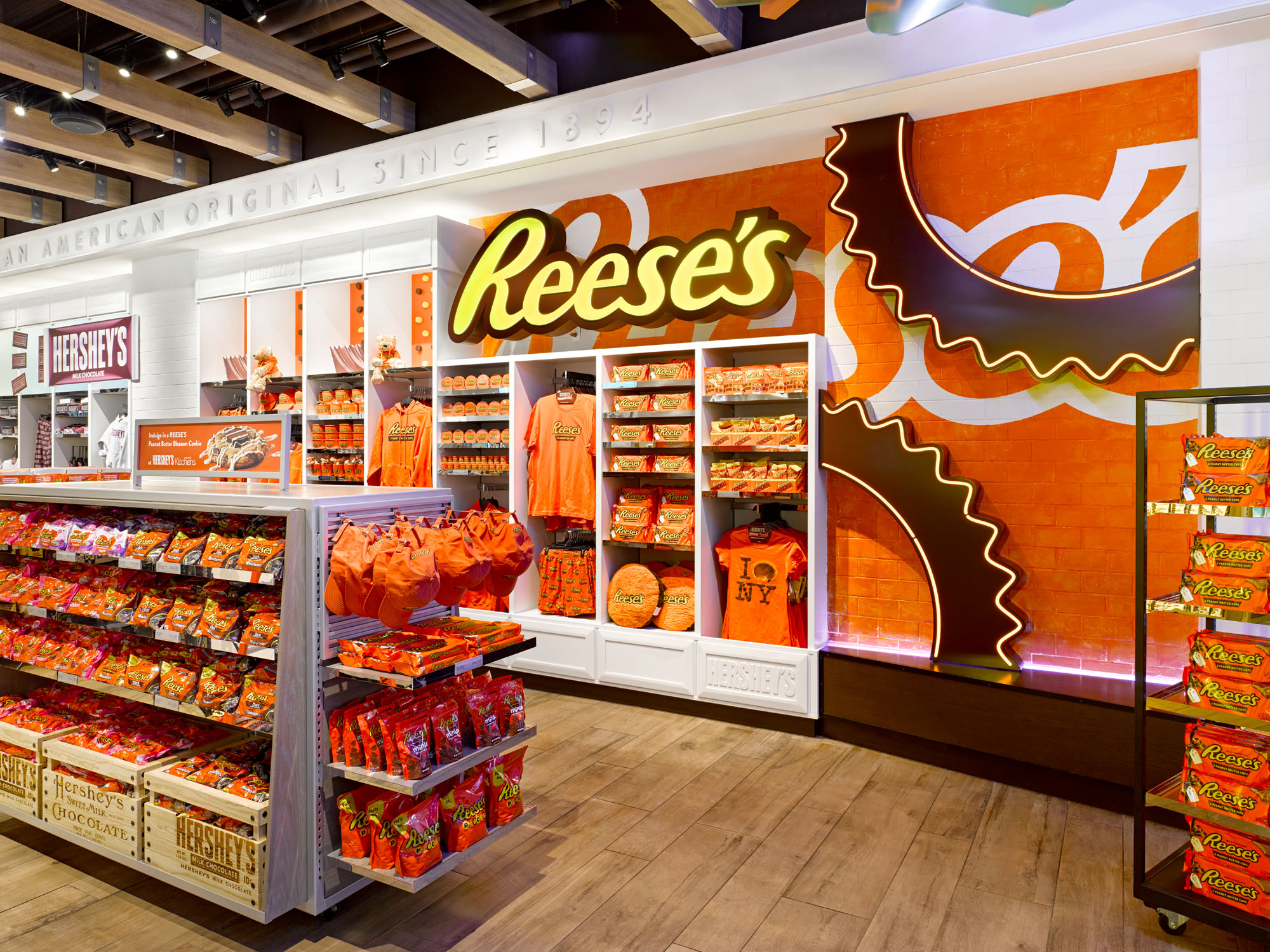
Hershey’s Chocolate World Times Square
A brand home is certainly an investment—but as with all investments, when strategically developed and well-designed, a brand home can provide invaluable opportunities for consumer engagement, a solid return on that investment and even additional revenue streams. Here are a few principles to consider when investing in a brand home experience:
- Go All-In. Brand homes are the biggest opportunity for the purest, most expressive version of your brand. Give your experience a distinct name and visual identity (à la Gucci Garden), and invest in architecture and interior design to activate your brand assets in a compelling physical environment.
- One Destination, Countless Experiences. Create several smaller experiences within the brand home to ensure guests spend more time (and perhaps more money), feel like the trip was worth their while and encourage repeat visits.
- Make it Exclusive. Invite guests behind-the-scenes, sell one-of-a-kind souvenirs and design unique experiences that guests can only encounter at the brand home.
Build-a-Bear
Forbes: Designing Offices To Address Introverts’ Re-Entry Anxieties
In a recent article with Forbes, teammate Anne Gibson discussed how she urges organizations to shift their philosophy from Activity-Based Work (ABW) to Behavioral-Based Work. Doing so would empower workers to choose how to work to enable their best performance.
“The future of office design should also support non-work-related activities that might appeal to introverts,” Gibson says. Settings “such as meditation space, makers rooms, outdoor seating or nap pods . . . signal that the office is about reconnecting for everyone, not just those who thrive in high-energy social settings.” Read more here.
Fast Company NY: How to Strengthen Your Customer Experience
Fast Company’s 2nd annual Innovation Festival brought together an amazing line-up of innovative thinkers-and-doers from across a wide spectrum of industries. Of particular interest was a session with Danny Meyer of the Union Square Hospitality Group (USHG) and Neil Blumenthal of Warby Parker, to discuss the impact of technology on customer experience, both in retail and restaurants. Along with creating a stimulating discussion on the topic of technology, the conversation also highlighted the growing importance of a “hospitality” mindset far beyond the world of restaurants and hotels.
Among the many interesting exchanges, several themes were highlighted:
- Using technology as a way to “increase human touch”: From Meyer’s “technology should never be used to remove people from the process” – to Warby Parker’s use of only implementing customer-facing technology for “low value” interaction (payment), in order to increase critical staff time for “high value” customer interaction (product selection), both speakers view technology as a tool to create efficiencies that allow for more human-to-human contact, not less.
- Collecting dots, knowing your customer: Both Meyer and Blumenthal agreed that one of the keys to creating successful customer interactions, whether in retail or restaurant, is knowing as much about your customer as possible. Both implement low tech solutions but agreed that digital technology is creating powerful tools that allow them to do so much more. Meyer cited his ABCD rule – “Always Be Collecting Dots, so you can be Always Connecting Dots”, as his technology agnostic mantra, to use every opportunity to know more about your customers, so that you can anticipate their wants and needs. Take for example the USHG partnership with Resy (the online reservation group) to connect their reservations database with their POS system in order to create customer profiles – to know not only when and where someone ate but now what they ordered, dietary restrictions, wine preferences and more. With these types of digital tools a level of personalization can be created that once was only available at five-star restaurants and luxury retailers.
- Social media, being part of the conversation: Dedicating significant resources to it, both speakers understand the importance of social media to their businesses. From USHG’s use of Venga technology to collect and aggregate all the digital conversations happening about their restaurants, to Warby Parker’s use of staff video responses to Tweeted customer questions, they both understand how critical it is to always be part of the conversation. Meyer specifically discussed the ability to respond in real time to an issue, so that masses of people don’t hear about it before the brand does. The sooner they can hear about an issue, the sooner they can fix it and transform that customer’s experience. In longer time frames, it also allows them to collect information and pick-up on any patterns that might arise, good and bad, and help them embrace or address them. In the case of Warby Parker’s video Tweet responses, beyond using them to “increase human touch” in the communication, which has proven to be a great tool in defusing contentious moments, the videos have become great marketing opportunities, retweeted tens of thousands of times.
- Staffing, use good tomatoes: Finally, both speakers drove home their belief that the wide variety of technologies they utilize are only tools and in the end only as good as the staff that uses them. From Warby Parker’s, “proactive, curious and passionate” hiring profile to USHG’s “High HQ (Hospitality Quotient) Profile”, they both are passionate that it comes down to people interacting with people. Using all the tools at their disposal, from artificial intelligence to eye contact, a great team uses every opportunity to create connections with customers, connections that transform those moments from “commodity exchanges” to a unique and memorable brand experience. Meyer strongly feels that there is a direct connection between staff happiness and customer happiness, one can never be greater than the other. Summing up this staffing philosophy with something he learned from his chefs … “the best tomato sauce recipe is only as good as the tomatoes you put into it”.
Converted Hotel Rooms Are Emerging as New Opportunities for Quiet Workspaces
As many Americans enter the fifth month of social distancing–and are still unable to return to the office–the lack of structure and boundaries are starting to take a toll. Read more here.